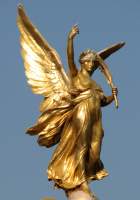
There are probably as many statues of angels across Britain as statues of anything: they start to appear in numbers in earlier church monuments, build up to a critical mass in Victorian times, and are still found in large numbers from Edwardian times and through to monuments to the fallen in World War I. The 1930s introduces a new type of angel, art deco, but by this time they are much less common, and since then have been sporadic at best. This page looks at a range of angel statues, mostly from Victorian times.
The statue at the top of this page exemplifies one of the best places for an angel statue, which is at the summit of a monument. This is Thomas Brock’s Angel of Victory, atop the Victoria Memorial. Summit angels give dramatic silhouettes of the upswept wings against the sky, and the Victoria Memorial one looks superb from almost any angle. Below we see some other summit angels: H. C. Fehr’s Angel of Victory in Eastbourne, and his closely related but not identical one in Colchester. Then the Cardiff Boer War Memorial, with summit angel by Albert Toft. As with the Victoria memorial, each of these has the long, diaphanous drapes and are standing or alighting on a globe.
Cardiff reminds us that our angel statues need not be female; here is the Welsh National Memorial summit figure, a nude male, again with an excellent silhouette to the wing, and again by Albert Toft. Between this figure and the examples above, we see the variation between angels' wings from longer, gull-like ones to shorter but more downy goose-like ones.
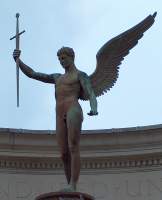 Albert Toft's Welsh National Memorial.
Albert Toft's Welsh National Memorial.
A couple more female examples. Below left, a 20th Century example, short-winged and with fine, playfully crinkled drapery, emplaced on the top of Fehr’s Leeds War Memorial, but not by him; and to the right George E. Wade’s summit Angel of Peace from the Norwich Boer War Memorial, seen here from a particularly satisfying side view.
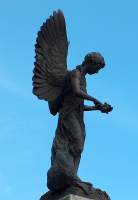
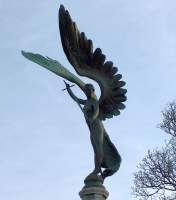 Summit angel figures in Leeds and Norwich.
Summit angel figures in Leeds and Norwich.
The upswept wings can be composed to give a harmonious, symmetrical ‘butterfly’ composition, as in the examples below. To the left, another example of the work of H. C. Fehr, a miniature rather than an outdoor monument summit angel this time, the symmetry of the wings and arms contrasting with the S-shaped swerve of the body and legs; to the right another Victory angel, once again alighting on a globe, with a careful moderation of the symmetrical outline by virtue of the position of the hands and the main fold across the lower legs.
Now for some architectural examples. Below are a pair of sculpted angels from above a subsidiary door to Westminster Cathedral, very close to Victoria Station, and then below that, a modern panel with angels from the exterior of the church of All Hallows Barking. The wings here are nicely used to echo and enhance the regular curves of which the composition is composed. The mid-Victorian roundel on the right, with angels in an internal quatrefoil, has the lines of the wings as shallower curves echoing those of the outer structure.
High relief angels at Westminster Cathedral, All Hallows Barking, and Westminster. Here are a typical early Victorian example from a pediment, and a pair of later Victorian angels used as spandrel figures,
and emblematic of painting and sculpture. The figure to the right is another spandrel angel, a male example,
the wing nicely fitted into the narrow shape made by the top of the arch. All these wings are fairly short, which is usually the
case in such cases, though not always. Notice that whatever the type of drapery, angels do not wear footgear - by convention they
are either barefoot as in these examples, or their feet are entirely concealed by flowing robes, as shown elsewhere on this page.
Angels can be used as structural supports, as in these caryatid figures on Marylebone Parish Church,
nicely catching the sun as seen from outside Baker Street Station. These are fairly unusual in having split skirts to show one leg, though
we will see a further example lower down this page. The wings are not just short, but because of the position of the figure, are small
and are not able to rise above the height of the head.
Here is the immense pair of angel statues acting as the top frame
to the principal window on Westminster Methodist Hall, by the sculptor Henry Poole. The wings are
entirely concealed, but we see them as angels because of the position of the feet, which make it clear they are posed in
mid-air rather than resting on any earthly support. Their hair and upper drapes whip back in some breeze. Next,
another pair of Caryatid angels, mid Victorian, with the wings being used to fill give a varied background
to the figure. Again the feet are floating up from the ground, but here rather curiously, for figures intended to be in place of pillars.
The issue is avoided in the caryatids above, by rooting the angels firmly on the ground; the height of the figures above the ground means
our attention is not drawn to this.
Lots more caryatids on this page. And below right is an example of a corbel angel
acting as a base of a pillar, most gracious in composition, and with our angel in full horizontal flight.
Angel sculpture as architectural elements: window top, caryatids, and a corbel. Into the churches now. Angels of course are often found on church monuments. There are any number of positions they can
take, including sitting on the tops of the larger monuments, but here we concentrate on high relief panels. Below left are a pair of trumpeting angels,
the sweep of their long robes leaving it ambiguous whether they are floating or on the ground.
Next, a charming composition with a careful use of the angels’ wings, which both form a harmonious curved
frame to the central scene, stopping the eye scanning too far to left or right on a horizontal composition,
and suggesting enfolding and protection. To the right, a vertical composition of three angels on a monument,
and to the far right a mourning angel, seminude, by Flaxman, a composition based on a series of
diagonal and curved lines. (This website has an introduction to church monuments for those interested.)
More church monuments. Here are three further examples of angel sculpture by Flaxman, that on the left showing a nude female
figure (hence a Soul) being pulled upwards towards Heaven by angels, with a group of putti frolicking
rather than pushing from below; the composition aims to fill the panel entirely with figures in a medieval fashion.
Next, two examples each with a mourner collapsed over a grave, with an accompanying angel: one
with the two separated figures contained within a lunette, the other with the figures brought together, and an overlap onto and across
the border. Of these three examples, the angels in the left hand panel are male or androgenous, the central lunette has an angel tending
towards the feminine, and that on the right is clearly female.
Flaxman compositions for church monuments. Apart from the monuments, and the corbels etc on the walls of churches, we should mention lecterns and fonts,
where the use of angels on the base was something of a fashion in Victorian times.
The example of a lectern below was a design used by Coalbrookdale in mid-Victorian times; the font is from a little later.
The pose of an angel with both arms held up in the lectern above is surprisingly uncommon, but below left is a rather similar pose used
in a 20th Century tomb monument by the sculptor Richard Goulden. The figure poises on tiptoe, as if about
to launch herself heavenwards.
We turn now to graveyard and cemetery monuments. The angel statue is ubiquitous in the graveyards on the monuments of the better off elements
of society. There is a sense that such angels, though, tend to the sentimental and the cloyingly sweet, as in these examples above.
There are conventional types, repeated over and over, the poses and mid-Victorian faces seen again and again. And yet, and yet,
we are compelled to take these sculptures seriously, for the sheer quality of the carving.
Look again at the example above on the left - you will need to click on it to see it properly – it falls squarely in the too-pretty category, and the idea of the long-haired young girl
leaning sadly against her clasped hands is conventional, and time has taken away the surface of the limestone, and yet,
the drapes alone put this work far above the average. The legs strain against the thin fabric, with the shape of the figure
emphasised, the curves of drapery on the torso and around the arms give a complete harmoniousness, and the flutter of
the drop fold behind at the base suggests the wind blowing against the otherwise still figure.
Below are several more examples of angel statues with fine drapery. That to the left, rather vertical, unusually for a cemetery monument,
has the heavy classical skirt swept back to expose one leg in a light shift.
By contrast, the upper garment forms a rather baroque fold under the arm.
The second figure has a twisted shroud about a body of slender youthfulness, carefully studied,
and giving a sense of motion arrested. Another finely twisted garment is in the third example, rather like on a Tanagra figurine,
giving a sense of long, attenuated limbs to accompany the long wings.
Second from the right we see a different type of folds, with the dress tightly round the legs,
and more loosely about the torso to form a zig zag composition of lines. I wanted to show this example because it
has the almost identical pose to our first example in the line above, but with a completely different evocation through
the differences in the drapes.
And to the far right, we have another tightly-bound figure, with complex, delicate creases to outline the form
of the upper body and stomach, deepening to stronger folds across the front of the lower legs. How strange it looks to
modern eyes to mingle this treatment with the pretty young face and coiffured hair.
We end with a few more sculptured angels in cemeteries. The reason for these ones is that unlike most monuments, whether in churches or museums or civic statues,
by convention, cemetery monuments are allowed to decay naturally, or become smothered in foliage.
It is sad that those who visit the great cemeteries in the future, no further away from our time than we are from the
Victorians who set up most of our monumental angels, are likely to find little remains of these statues. But it is undeniable that the part-ruined statues of angels
are among the most evocative images of the times.
Sculpture pages // Mermaid sculptures // Cherub sculptures // Introduction to church monuments
Visits to this page from 13 Mar 2014: 34,167

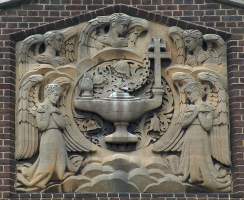
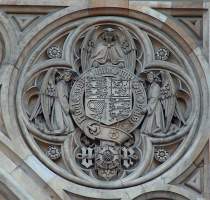
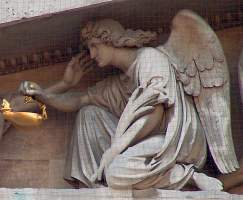
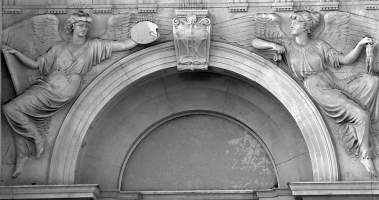
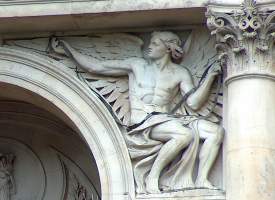 Angels composed in architectural surrounds: pediment and spandrel positions.
Angels composed in architectural surrounds: pediment and spandrel positions.
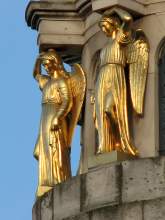 Marylebone Parish Church angels.
Marylebone Parish Church angels.
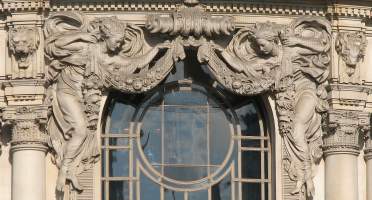

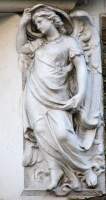
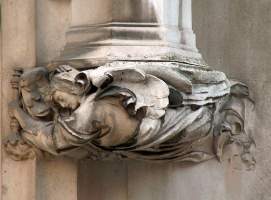
Angels in churches
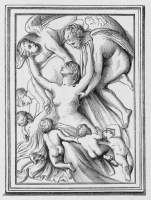
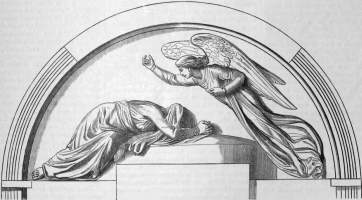
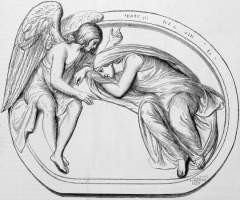

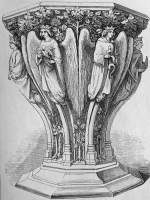 Victorian angel lectern and font.
Victorian angel lectern and font.
 Angel with arms up by Richard Goulden.
Angel with arms up by Richard Goulden.
Graveyard and cemetery angel statues